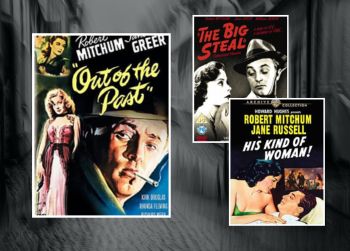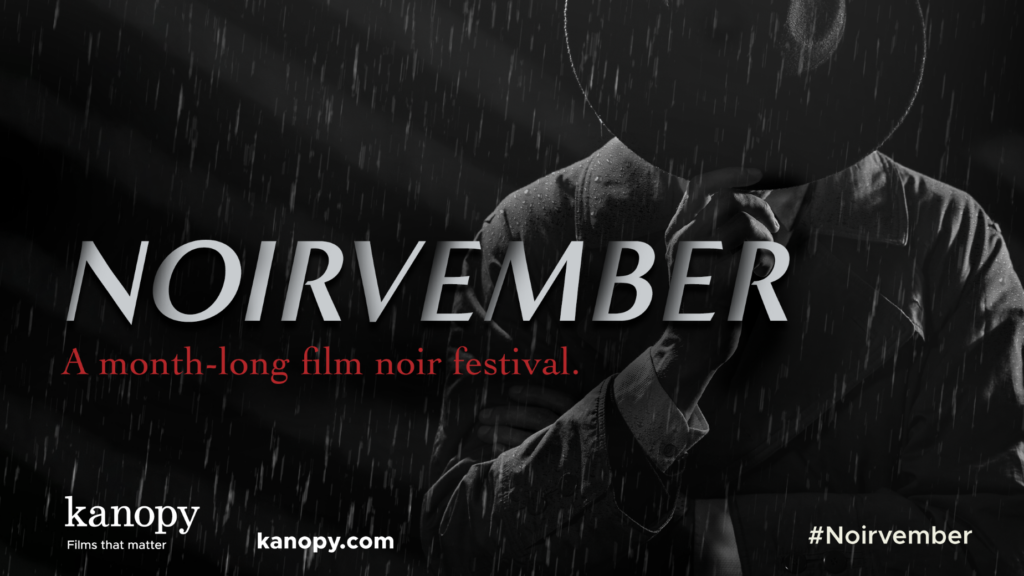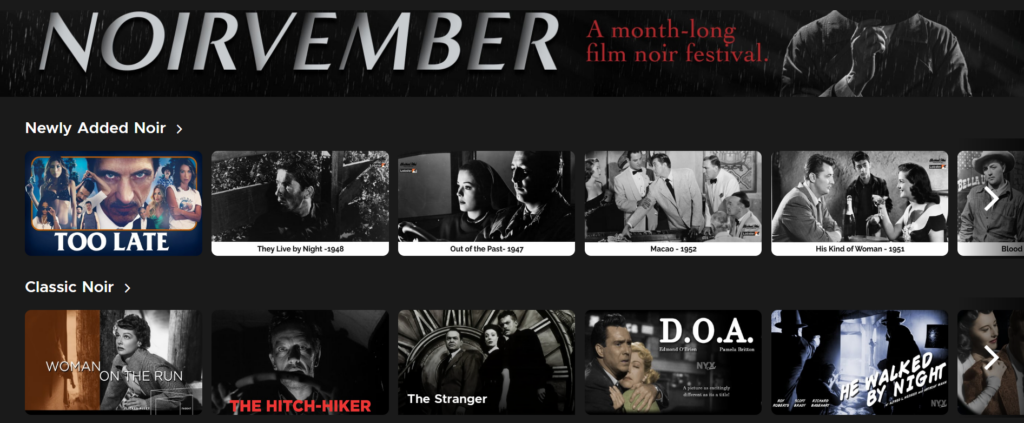Ready for cynical heroes, intricate plots, and underlying existentialism? Sounds like you’re ready to get moody with Kanopy’s Noirvember collection.
Following the end of World War Two, French publishing house Gallimard started publishing translations of American crime novels through its Série noire imprint: including authors such as Dashiell Hammett, Raymond Chandler, James M. Cain and David Goodis. The following year, French critic Nino Frank wrote the earliest essays identifying a new departure in American film making, the ‘film noir’- though the term itself did not come into ‘official’ use until the publication of Raymond Borde & Etienne Chaumeton’s study ‘Panarama du film noir americain’ in 1955, and wasn’t widely adopted in America until the 1970’s. According to Borde and Chaumeton, the ‘noir’ cycle officially begins with John Houston’s The Maltese Falcon (1941) and ends with Robert Aldrich’s Kiss Me Deadly (1955) – though the style can be traced back as far as Fritz Lang’s M (1931), and forward to films like Memento (2000).
Characterised by fear, mistrust, bleakness, paranoia, fatalism, disillusionment, existential plots and confessional voiceovers, they provided a distinctly pessimistic view of post-war America. However, while the view was American, the ‘feel’ was distinctly European with shadowy expressionistic lighting, stark and skewered camera angles, jarring editing and deep shadows. Due to this style, the best noirs are in black and white – with key European directors such as Fritz Lang, Robert Siodmak, and Jacques Tourneur. Noir protagonists were typically anti-heroes: crooked cops, down and out private eyes, war veterans, petty criminals, gamblers and killers; while the women were often unloving, mysterious, duplicitous and manipulative – but always gorgeous.
While the style dropped out of favour after the late 1950’s, its elements were present in several standout films of the 1960’s, from The Manchurian Candidate (1962) to Point Blank (1967). It made a resurgence in the 1970’s, and an even stronger one in the 1990’s. Films from this period on are referred to as ‘neo-noir’ and, while some are merely an affected stylism, enough original ‘noir’ runs through them to satisfy purists. Since then, these influential cinematic works have grown in popularity as modern filmmakers use similar aesthetics.
Whether you’re looking to dive into the dark world of the classic genre, or want to see what updates have been made to keep the concept fresh, you can explore Kanopy’s well-rounded collection here.
Film Noir ‘The Mitchum Way’: Our mini festival watchlist
To celebrate Kanopy’s ‘Noirvember’ we’ve created a mini-festival tribute to one of film noir’s most iconic actors, the legendary Robert Mitchum. Few actors could exude the level of laconic fatalism that he brought to his roles, as that is well evidenced in the movies below.
Out of the Past (1947)
 Robert Mitchum is Jeff Bailey, the owner of a small garage and living an idyllic life in small town California… until his past catches up with him in the form of ruthless gangster Whit Sterling (Kirk Douglas) and his girlfriend Kathie Moffat (Jane Greer). Jacques Tourneur’s brilliantly realised Noir is one of the best examples of the genre. Flashbacks within flashbacks reveal Mitchum’s past as Private Eye Jeff Markham hired by Douglas to retrieve his wayward girlfriend Grier, and the $40,000 of his money she ran off with. He manages to track her to Mexico, but that’s just the beginning of his ensnarement with the nasty pair. Mitchum is at his laconic best as Markham, conveying the characters desperation with the most economic of gestures, and the beautiful Greer is nothing short of brilliant as the remorseless femme fatale. Tourneur’s camerawork and use of light and shadow convey an inky darkness to even the most sunlit scene. The film was adapted by Daniel Mainwaring (using the pseudonym Geoffrey Homes) from his own 1946 novel Build My Gallows High, and is one of those instances where the film improves on the book, though that may have been due to the uncredited dialogue revisions by Frank Fenton, a B-movie writer whose best known credit was John Ford’s Wings of Eagles.
Robert Mitchum is Jeff Bailey, the owner of a small garage and living an idyllic life in small town California… until his past catches up with him in the form of ruthless gangster Whit Sterling (Kirk Douglas) and his girlfriend Kathie Moffat (Jane Greer). Jacques Tourneur’s brilliantly realised Noir is one of the best examples of the genre. Flashbacks within flashbacks reveal Mitchum’s past as Private Eye Jeff Markham hired by Douglas to retrieve his wayward girlfriend Grier, and the $40,000 of his money she ran off with. He manages to track her to Mexico, but that’s just the beginning of his ensnarement with the nasty pair. Mitchum is at his laconic best as Markham, conveying the characters desperation with the most economic of gestures, and the beautiful Greer is nothing short of brilliant as the remorseless femme fatale. Tourneur’s camerawork and use of light and shadow convey an inky darkness to even the most sunlit scene. The film was adapted by Daniel Mainwaring (using the pseudonym Geoffrey Homes) from his own 1946 novel Build My Gallows High, and is one of those instances where the film improves on the book, though that may have been due to the uncredited dialogue revisions by Frank Fenton, a B-movie writer whose best known credit was John Ford’s Wings of Eagles.
The Big Steal (1949)
 This 1949 film reunites Mitchum with Jane Greer from 1947’s Out Of The Past. It’s directed by Don Siegel, who is best remembered for the 1956 sci-fi classic Invasion of the Body Snatchers, but who would also strike gold directing five Clint Eastwood films in the 70s, including the classics Dirty Harry and Escape from Alcatraz. The script is based on the short story The Road to Carmichael’s by Richard Wormser, a prolific pulp crime and western writer remembered by paperback aficionados for a series of tight crime procedurals he wrote in the 60s (Drive East on 66, A Nice Girl Like You), and for winning the Edgar award for their best original paperback novel winner The Invader in 1973. The film sees Mitchum play a U.S. Army Lieutenant who is robbed of a $300,000 army payroll. When his superior (the ever-reliable B-movie stalwart William Bendix) suspects him of having taken part in the theft, he pursues the thief to Mexico where he meets Jane Greer’s character, who is also after the same man. Plenty of twists and double-crosses ensue in the tight 71 minute runtime, and Greer’s character proves herself to be as fast-talking and capable as the male leads.
This 1949 film reunites Mitchum with Jane Greer from 1947’s Out Of The Past. It’s directed by Don Siegel, who is best remembered for the 1956 sci-fi classic Invasion of the Body Snatchers, but who would also strike gold directing five Clint Eastwood films in the 70s, including the classics Dirty Harry and Escape from Alcatraz. The script is based on the short story The Road to Carmichael’s by Richard Wormser, a prolific pulp crime and western writer remembered by paperback aficionados for a series of tight crime procedurals he wrote in the 60s (Drive East on 66, A Nice Girl Like You), and for winning the Edgar award for their best original paperback novel winner The Invader in 1973. The film sees Mitchum play a U.S. Army Lieutenant who is robbed of a $300,000 army payroll. When his superior (the ever-reliable B-movie stalwart William Bendix) suspects him of having taken part in the theft, he pursues the thief to Mexico where he meets Jane Greer’s character, who is also after the same man. Plenty of twists and double-crosses ensue in the tight 71 minute runtime, and Greer’s character proves herself to be as fast-talking and capable as the male leads.
His Kind of Woman (1951)
 In His Kind of Woman, Mitchum teams up with Jane Russell, with support from actors who would go on to become household names also – Vincent Price and Raymond Burr. The film was helmed by John Farrow, but RKO boss Howard Hughes was so unhappy with the result that he ordered extensive reshoots, which ended up costing as much as the original shoot, recasting and reshooting the crime boss character with two different actors before he settled on Burr. Mitchum plays a down on his luck professional gambler who is convinced to accept a $50k year-long mysterious job at a Mexican resort. There he becomes entangled with a variety of characters, including Russell and an extradited underworld crime boss (Burr). He comes to believe he has been cast as a patsy so Burr can assume his identity to return to the US. The film was designed to send up some of the existing noir troupes, so there are some oddball comedy elements, courtesy of ham Shakespearean actor Mark Cardigan played by Vincent Price, and they end up providing a nice juxtaposition with the escalating tension of Mitchum’s situation with crime boss Barr.
In His Kind of Woman, Mitchum teams up with Jane Russell, with support from actors who would go on to become household names also – Vincent Price and Raymond Burr. The film was helmed by John Farrow, but RKO boss Howard Hughes was so unhappy with the result that he ordered extensive reshoots, which ended up costing as much as the original shoot, recasting and reshooting the crime boss character with two different actors before he settled on Burr. Mitchum plays a down on his luck professional gambler who is convinced to accept a $50k year-long mysterious job at a Mexican resort. There he becomes entangled with a variety of characters, including Russell and an extradited underworld crime boss (Burr). He comes to believe he has been cast as a patsy so Burr can assume his identity to return to the US. The film was designed to send up some of the existing noir troupes, so there are some oddball comedy elements, courtesy of ham Shakespearean actor Mark Cardigan played by Vincent Price, and they end up providing a nice juxtaposition with the escalating tension of Mitchum’s situation with crime boss Barr.
Macao (1952)
 The chemistry of Jane Russell and Mitchum in His Kind of Woman was so good that they were immediately re-teamed for the 1952 RKO film ‘Macao’. Directed by Josef von Sternberg and Nicholas Ray, it starred William Bendix and Gloria Grahame, alongside Mitchum and Russell. Three strangers arrive at the port of Macao, 30 miles off colonial Hong Kong: Nick Cochran, a cynical, but honest ex-serviceman; Julie Benton a sultry, and well-travelled night club singer; and Lawrence Trumble, a jovial traveling salesman. Russell is soon hired by the American expatriate who runs the biggest casino in Macao and has a side business in converting hot jewels into cash. He has been tipped off that an undercover cop is seeking to lure him into international waters where he can be apprehended for murder, and thinks Mitchum is the cop. Soon Mitchum finds himself bribed, beaten up, and in possession of a hot diamond necklace, as the film’s twists reveal just exactly who is who. Von Sternberg hated the script, Nicholas Ray was brought in to redo the final fight scenes, and the film was originally considered a commercial dud – a pedestrian story enlivened by some atmospheric and artistic direction. However, in recent times it has undergone a bit of a reappraisal and is now regarded as an overlooked gem, full of great acting turns and an entertaining story that makes up for any deficiencies in the screenplay.
The chemistry of Jane Russell and Mitchum in His Kind of Woman was so good that they were immediately re-teamed for the 1952 RKO film ‘Macao’. Directed by Josef von Sternberg and Nicholas Ray, it starred William Bendix and Gloria Grahame, alongside Mitchum and Russell. Three strangers arrive at the port of Macao, 30 miles off colonial Hong Kong: Nick Cochran, a cynical, but honest ex-serviceman; Julie Benton a sultry, and well-travelled night club singer; and Lawrence Trumble, a jovial traveling salesman. Russell is soon hired by the American expatriate who runs the biggest casino in Macao and has a side business in converting hot jewels into cash. He has been tipped off that an undercover cop is seeking to lure him into international waters where he can be apprehended for murder, and thinks Mitchum is the cop. Soon Mitchum finds himself bribed, beaten up, and in possession of a hot diamond necklace, as the film’s twists reveal just exactly who is who. Von Sternberg hated the script, Nicholas Ray was brought in to redo the final fight scenes, and the film was originally considered a commercial dud – a pedestrian story enlivened by some atmospheric and artistic direction. However, in recent times it has undergone a bit of a reappraisal and is now regarded as an overlooked gem, full of great acting turns and an entertaining story that makes up for any deficiencies in the screenplay.
Angel Face (1952)
 Angel Face was directed by Otto Preminger, and starred Jean Simmons, alongside Mitchum. Mitchum plays an ambulance driver who responds to a call at a wealthy mansion. A rich woman has almost asphyxiated from the gas in her unlit bedroom fireplace. But was it a suicide attempt, or something more sinister? He soon becomes involved with this wealthy family and their mysterious stepdaughter (Simmons), who quickly pursues and infatuates him. Under her influence he is soon the family chauffeur, ensconced on their estate, but he gradually begins to suspect there is something dangerous lurking under her beautiful surface… Original reviews found fault with this overtly Freudian drama, with its brooding, gothic overtones, amoral psychological character takes and super-bleak ending. However, it also underwent a re-evaluation over time and, with the changing social-sexual mores of later decades, is now recognised as a powerful character study of a fractured psyche and obsessive psycho-sexual destructiveness. Dimitri Tiomkin’s tense and melancholic musical score is a particular highlight.
Angel Face was directed by Otto Preminger, and starred Jean Simmons, alongside Mitchum. Mitchum plays an ambulance driver who responds to a call at a wealthy mansion. A rich woman has almost asphyxiated from the gas in her unlit bedroom fireplace. But was it a suicide attempt, or something more sinister? He soon becomes involved with this wealthy family and their mysterious stepdaughter (Simmons), who quickly pursues and infatuates him. Under her influence he is soon the family chauffeur, ensconced on their estate, but he gradually begins to suspect there is something dangerous lurking under her beautiful surface… Original reviews found fault with this overtly Freudian drama, with its brooding, gothic overtones, amoral psychological character takes and super-bleak ending. However, it also underwent a re-evaluation over time and, with the changing social-sexual mores of later decades, is now recognised as a powerful character study of a fractured psyche and obsessive psycho-sexual destructiveness. Dimitri Tiomkin’s tense and melancholic musical score is a particular highlight.
Some new changes to how you use Kanopy
In the past when you used the Kanopy streaming movie service available via our library subscription, you had a monthly allocation of six play credits. From November 1st “credits” became “tickets”, and the amount allocated monthly to you changed to 18 tickets. More information on these changes can be found here.
Books on film noir
The rough guide to film noir / Ballinger, Alexander
“From dimly lit streets and glamorous apartments to world-weary detectives and irresistible femmes fatales, The Rough Guide to Film Noir illuminates every corner of cinema’s darkest and most compelling genre. From early masterpieces like Double Indemnity and Kiss Me Deadly through to neo-noir classics such as Chinatown and LA Confidential, this book highlights all the groundbreaking noir movies. There are profiles of legendary performers such as Humphrey Bogart and Barbara Stanwyck, great directors like Fritz Lang plus key cinematographers, composers and designers. Complete with website listings and books for further reading, this Rough Guide takes a fascinating look at the noir movies made in the Classical Hollywood era and beyond.” (Catalogue)
The art of noir : the posters and graphics from the classic era of film noir / Muller, Eddie
“Film noir is about style as much as it is about,crime, with poster art that features a bold look,and iconography all its own – a sizzling marriage,of sex and violence. This is the first book to,present this striking artwork in a lavishly,produced, large-format volume featuring 275,colour images of posters and other promotional,material from the golden age of noir. Featuring,such classics as Touch of Evil and The Big Sleep. Noir expert Eddie Muller also provides background,information on all of the illustrators.” (Catalogue)
Film noir : 100 all-time favorites
” Into the shadows: Noir in the spotlight Enter a world populated by private eyes, gangsters, psychopaths, and femmes fatales, where deception, lust, and betrayal run rampant… If your heart rate just increased a bit, you’ll covet this book—the first film-by-film photography book on film noir and neo-noir. Beginning with silent, German, and French films that were early influences on the genre, through to seminal works such as Double Indemnity, The Postman Always Rings Twice, and Vertigo, you’ll make your way to the present day via Chinatown, Pulp Fiction, Heat,Memento, and the recent cult favorite Drive. Entries include posters, tons of rare stills, cast/crew details, quotes from the films and from critics, and analyses of the films. Film director, film noir scholar, and Taxi Driverscreenwriter Paul Schrader provides the introduction to this feast of noir worship. Populated by the genre’s most revered directors like Hitchcock, Wilder, Welles, Polanski, Mann, and Scorsese, the book also pays homage to its iconic faces such as those of Mitchum, Bogart, Hayworth, Bergman, Grant, Bacall, Crawford, Nicholson, Pacino, and so many more. ” (Catalogue)




